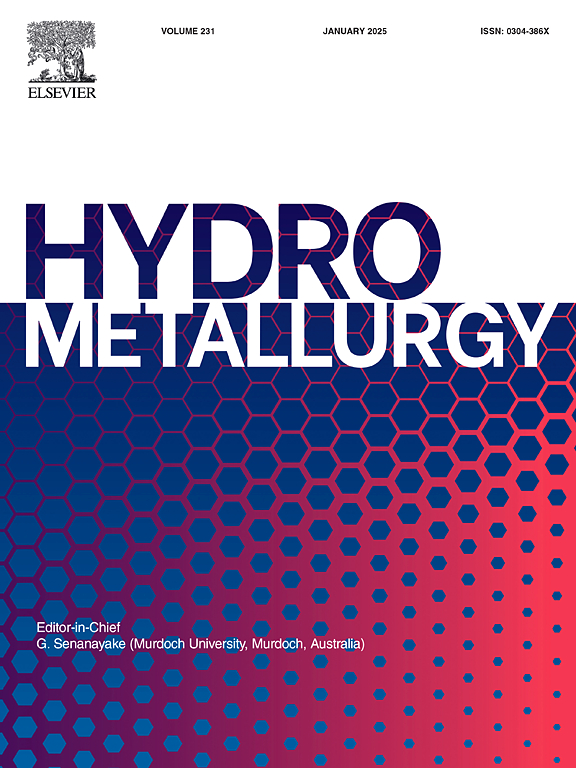Reducing silica in zirconium leachate from washed and dried frit powder: Role of cold and concentrated nitric acid and avoidance of crud formation
IF 4.8
2区 材料科学
Q1 METALLURGY & METALLURGICAL ENGINEERING
引用次数: 0
Abstract
Traditionally zirconium is leached from washed dried frit (WDF) powder using commercial-grade nitric acid at 80 °C, which results in a leachate containing significant colloidal silica, leading to emulsion and solvent loss. This work used red fuming nitric acid (RFNA) which consists of 84 % nitric acid, 13 % dinitrogen tetroxide and 1–2 % water, as a novel leaching agent. The reduced water content in RFNA enhances the acid strength and prevents colloidal silica formation. This improves zirconium recovery and reduces co-leaching of silica. Optimization efforts focused on operating parameters (impeller speed, temperature, time, acid concentration, liquid-to-solid ratio during reaction and washing steps) to maximize zirconium recovery while minimizing silica in the pregnant leach solution (PLS). Avrami-Erofeev model was used to identify the reaction regime and estimate the apparent rate of leaching. The leaching process was found to follow a complex mechanism. Fourier-transform infrared (FT-IR) spectra of leach residue were analysed to characterize the silica. Zirconium concentration in the PLS from WDF powder dissolved in concentrated nitric acid reached approximately 87 g/L compared to 67 g/L using hot acid leaching (29.8 % increase). Silica concentration decreased from 6500 mg/L to 400 mg/L (93.8 % decrease) using this novel approach, achieving nearly 30 % higher zirconium concentration in the PLS compared to traditional methods.
从洗净和干燥的水果粉中还原锆渗滤液中的二氧化硅:冷和浓硝酸的作用和避免杂质的形成
传统上,锆是从水洗的干果(WDF)粉末中浸出的,使用商业级硝酸在80°C下浸出,这导致浸出液中含有大量胶体二氧化硅,导致乳液和溶剂损失。本文采用由84%硝酸、13%四氧化二氮和1 - 2%水组成的红发烟硝酸(RFNA)作为新型浸出剂。RFNA中减少的含水量提高了酸强度,防止了二氧化硅胶体的形成。这提高了锆的回收率,减少了二氧化硅的共浸出。优化工作主要集中在操作参数(叶轮转速、温度、时间、酸浓度、反应过程中的液固比和洗涤步骤)上,以最大限度地提高锆的回收率,同时最大限度地减少怀孕浸出液(PLS)中的二氧化硅。采用Avrami-Erofeev模型确定了反应过程,并估算了浸出表观速率。发现浸出过程遵循一个复杂的机制。对浸出渣的傅里叶红外光谱(FT-IR)进行了表征。在浓硝酸中溶解的WDF粉末的PLS中锆的浓度达到约87 g/L,而热酸浸的浓度为67 g/L(提高29.8%)。使用这种新方法,二氧化硅浓度从6500 mg/L降低到400 mg/L(降低93.8%),与传统方法相比,PLS中的锆浓度提高了近30%。
本文章由计算机程序翻译,如有差异,请以英文原文为准。
求助全文
约1分钟内获得全文
求助全文
来源期刊

Hydrometallurgy
工程技术-冶金工程
CiteScore
9.50
自引率
6.40%
发文量
144
审稿时长
3.4 months
期刊介绍:
Hydrometallurgy aims to compile studies on novel processes, process design, chemistry, modelling, control, economics and interfaces between unit operations, and to provide a forum for discussions on case histories and operational difficulties.
Topics covered include: leaching of metal values by chemical reagents or bacterial action at ambient or elevated pressures and temperatures; separation of solids from leach liquors; removal of impurities and recovery of metal values by precipitation, ion exchange, solvent extraction, gaseous reduction, cementation, electro-winning and electro-refining; pre-treatment of ores by roasting or chemical treatments such as halogenation or reduction; recycling of reagents and treatment of effluents.
 求助内容:
求助内容: 应助结果提醒方式:
应助结果提醒方式:


